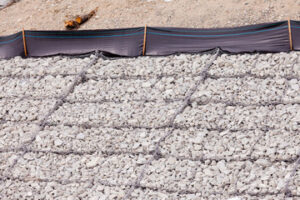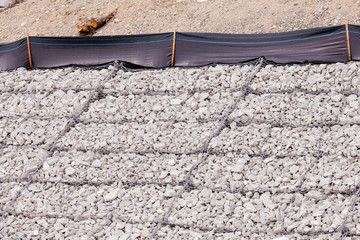The erosion of soil by wind and water can destroy habitats for wildlife, carry sediment to other sites, and reduce crop yields. Many of these problems can be addressed with Erosion Control Charleston SC.
To identify problem areas, look for muddy or dirty water. These areas may indicate that the water is washing away soil.
Vegetative barriers are a natural way to reduce erosion on croplands. They are strips of stiff-stemmed perennial grasses installed along the general contour or across concentrated flow areas to retard runoff and promote soil health.
Vegetive barriers can be planted with a variety of warm-season grasses such as sambuta (Saccharum spp. ), vetiver (Vetiveria zizanioides), and lemongrass (Cymbopogon citratus). In addition to their soil conservation benefits, these grasses are well known for their air pollution abatement potential.
Field research has shown that vegetative barriers significantly reduce near-road pollutant concentrations by three mechanisms: (1) they slow the rate of erosion; (2) they deflect erosion from slopes and channels; and (3) they enhance the dispersion of contaminant plumes. However, the relative role of each mechanism varies by barrier size and configuration, as well as the type of vegetation used for the barriers.
Unlike conventional tillage, vegetative barriers do not disturb the underlying soil. Therefore, they are not expected to change the erodibility of the underlying soils and do not require tillage every year. They also tend to be more durable than traditional tillage measures.
The NRCS recommends using vegetative barriers for high-erosivity soil types such as sandy loams and clays. The use of vegetative barriers can be a great complement to other soil conservation practices such as filter strips and terraces.
Vegetative barriers are also effective in reducing sediment loss from cropland. They can be placed in the upper 3 feet of buffer strips to prevent head cuts from developing into fields and to retard and disperse runoff from low spots within a field. Barriers built from coconut-fiber bales performed better than those constructed of straw or wood chips for regulating sediment flows (Manning’s n values of 1.355, 1.049, and 2.231 s m-1/3 and a sediment deposition ratio of 19%, 38%, and 64% for straw, wood chip, and coconut-fiber barriers, respectively).
To be successful, vegetative barriers must be designed to meet local conditions. They should be located at a gradient of 0.6 percent or less, except where they cross concentrated flow areas, and they should be spaced appropriately to achieve the desired conservation objective.
Brush Mattresses
Brush mattresses are a form of vegetative bank protection that uses a matrix of dormant branch cuttings to cover and stabilize streambanks. They are most successful on slopes no steeper than 2:1 and are designed to immediately slow water velocities, intercept sediments, and allow the establishment of a dense network of plant roots.
A brush mattress is installed by grading a streambank to the desired stable angle and then constructing a mat of dormant branch cuttings. It is layered onto the bank and held down with stakes, often along with a live fascine or rock toe protection. The stakes are hammered in at 0.9 to 1.2 m (3 to 4 ft) centers and secured with cord or wire. The mattress is then planted during the non-growing season and staked with clove hitches using a machine-spun coir rope or 10 to 12 gauge galvanized annealed wire, tied in a diamond pattern between each set of stakes (Allen & Fischenich, 2001; Johnson & Stypula, 1993; McCullah, 2004).
Once the roots of the willows in the brush mat grow, they act as a natural barrier to downhill erosion. They also enhance riparian habitat and serve as an excellent site for the colonization of native vegetation. They reduce soil erosion and intercept sediment, as well as improve non-point pollution control by shading the stream, reducing water temperatures, and offering protection from predators.
In central Europe, sloped embankments of navigable waterways are protected against ship-induced hydraulic loads by technical revetments consisting of armor stones on a filter-stable geotextile or mineral filter. In order to evaluate the resilience of these bioengineering measures, a new method was developed for testing their mechanical filtration stability. Willow brush mattresses were flooded and drained in test apparatuses in order to simulate ship-induced drawdowns. The results showed that after a short growth period of one to three months, basket willow and silver willow brush mattresses significantly reduced soil erosion. They thus proved to be mechanically filter-stable.
Mulch
Mulch is a layer of material placed on the ground, usually a few inches deep, to suppress weeds, increase or decrease soil temperature, conserve moisture, and enhance the beauty of landscaping. Mulch is available in organic and inorganic forms. Organic mulches such as compost, wood chippings, processed conifer bark, leaf mold, well-rotted manure, grass clippings, hay, straw (for strawberries), and spent hops break down over time to add nutrients to the soil and improve its structure. They must be regularly reapplied. Inorganic mulches such as gravel, black plastic, or fabric perform many of the same functions but do not add organic matter to the soil.
The erosion control plan should clearly outline who is responsible for erosion and sediment control maintenance on the project and when this will be provided. This should be based on site conditions, design safeguards, construction sequence, and anticipated weather conditions. It is also important to provide a schedule for the removal of temporary erosion control practices, including waste disposal areas, once they are no longer needed.
Erosion control measures should be inspected regularly to ensure they are functioning properly and have not been damaged by construction activities. All contractors should document erosion control work in the job site log.
Sediments from disturbed soils can erode into nearby rivers and streams, damaging fish habitats, sewer systems, and natural watersheds. In Oregon, excessive sediment pollution is prohibited by the Clean Water Act.
Erosion prevention measures should be inspected and maintained at least twice a year by a qualified person. In addition, all erosion and sediment control practices should be inspected after each rain event to determine their effectiveness. The inspection should include a visual examination of the slope to evaluate how much sediment has been moved by the storm, as well as a physical probe of the surface of the soil to see how loose it is and what type of slope it has. The inspector should record their observations and any recommendations for improving the effectiveness of the practice. An additional step would be to have the inspector review the sediment discharge report from the construction site.
Replanting
The goal of erosion control is to limit ground disturbance, separate pollutants from stormwater runoff, and stabilize disturbed soil as soon as possible. There are many erosion control products and methods that can be used in construction, agriculture, fire remediation, environmental restoration, landscaping, and stormwater management. Companies that disturb the environment and natural land are required to use effective erosion control practices or risk fines.
Erosion is a natural process of moving and depositing soil particles, but when it’s accelerated through development and agricultural processes, the effects can be devastating to people as well as wildlife. Erosion is also one of the most costly pollutants and affects our water quality. Systems and treatments that reduce erosion and sediment transport reduce the costs of cleaning up polluted water and protect our water bodies.
Whenever possible, limit the area of disturbance and leave undisturbed areas intact. This is especially important during the wet season, when the soil is prone to erosion. Providing a vegetative cover and soil stabilization is the most cost-effective way to prevent erosion and sediment transport. Keeping dense and diverse vegetation on riverbanks, lake shores, and runoff slopes prevents erosion by dissipating energy from wave and current action. In addition, an interwoven layer of roots on wetland bottoms and banks stabilizes the soil against erosion by wind and wave action.
Once the principal erosion control treatments are in place, the final phase is to install and implement functional best management practices that will keep the soil on site and out of the water body, adjacent property, public rights-of-way, and storm sewer and drainage systems. These best management practices must be inspected, maintained, and made functional before any ground-disturbing activity is initiated, inspected throughout the construction process by both city staff and the on-site erosion and sediment control manager, and kept in place until the site has been permanently stabilized.
When sediment control best management practices are installed on a project, they must be inspected and maintained daily for adequate coverage and performance. The inspection should include checking staking patterns, anchor slot backfill, soil contact, debris removal, and whether the upslope blanket edges overlap with the downslope blanket edges (to prevent sediment washout). Sediment traps and barriers must be inspected for adequate coverage and performance before and after each rain event.

